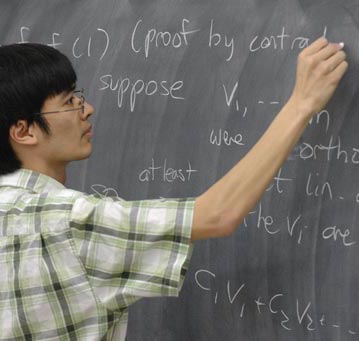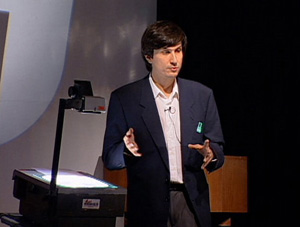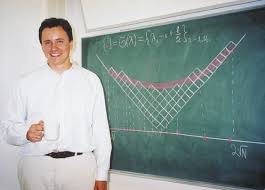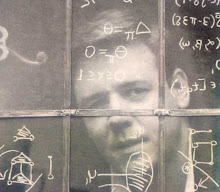
Terence Chi-Shen Tao FRS (born July 17, 1975, Adelaide, South Australia) is an Australian mathematician working primarily on harmonic analysis, partial differential equations, combinatorics, analytic number theory and representation theory. His single most famous result is a proof, in joint work with British mathematician Ben J. Green, that there exist arbitrarily long arithmetic progressions of prime numbers (the Green–Tao theorem). Tao is currently a professor of mathematics at the University of California, Los Angeles.
In August 2006, he was awarded a Fields Medal, widely considered the top honor a mathematician can receive. Just one month later, in September 2006, he was awarded a MacArthur Fellowship. He was elected a Fellow of the Royal Society on May 18, 2007.
He received the Salem Prize in 2000, the Bôcher Prize in 2002, and the Clay Research Award in 2003, for his contributions to analysis including work on the Kakeya conjecture and wave maps. In 2005 he received the American Mathematical Society's Levi L. Conant Prize with Allen Knutson, and in 2006 he was awarded the SASTRA Ramanujan Prize.
In 2004, Ben Green and Tao released a preprint proving what is now known as the Green-Tao theorem. This theorem states that there are arbitrarily long arithmetic progressions of prime numbers. The New York Times described it this way:
| “ | In 2004, Dr. Tao, along with Ben Green, a mathematician now at the University of Cambridge in England, solved a problem related to the Twin Prime Conjecture by looking at prime number progressions—series of numbers equally spaced. (For example, 3, 7 and 11 constitute a progression of prime numbers with a spacing of 4; the next number in the sequence, 15, is not prime.) Dr. Tao and Dr. Green proved that it is always possible to find, somewhere in the infinity of integers, a progression of prime numbers of equal spacing and any length. | ” |
For this and other work, he was awarded the Australian Mathematical Society Medal in 2005.
In 2006, at the 25th Intenational Congress of Mathematicians in Madrid, he became one of the youngest, the first Australian, and the first UCLA faculty member ever to be awarded a Fields Medal. An article by New Scientist writes of his ability:
| “ | Such is Tao’s reputation that mathematicians now compete to interest him in their problems, and he is becoming a kind of Mr Fix-it for frustrated researchers. “If you're stuck on a problem, then one way out is to interest Terence Tao,” says Fefferman. | ” |
Tao was a finalist to become Australian of the Year in 2007.
In April 2008 Tao received the Alan T. Waterman Award, which recognizes an early career scientist for outstanding contributions in their field. In addition to a medal, Waterman awardees also receive a $500,000 grant for advanced research.
In December 2008 he was named The Lars Onsager lecturer of 2008, for “his combination of mathematical depth, width and volume in a manner unprecedented in contemporary mathematics”. He was presented the Onsager Medal, and held his Lars Onsager lecture entitled “Structure and randomness in the prime numbers” at NTNU, Norway.
Click to Download : Global regularity of wave maps V. Large data local wellposedness and perturbation theory in the energy clas.
Click to Download : Global existence and uniqueness results for weak solutions of the focusing mass-critical non-linear Schrödinger equatio.
Click to Download : Global regularity of wave maps IV. Absence of stationary or self-similar solutions in the energy clas.
Click to Download : Global regularity of wave maps III. Large energy from $\R^{1+2}$ to hyperbolic space.
Click to Download : A global compact attractor for high-dimensional defocusing non-linear Schrödinger equations with potential.
Click to Download : On the testability and repair of hereditary hypergraph properties (with Tim Austin).
Click to Download : Random Matrices: The circular Law (with Van Vu).
Click to Download : Multi-linear multipliers associated to simplexes of arbitrary length (with Camil Muscalu and Christoph Thiele).
Click to Download : Linear Equations in Primes (with Ben Green).
Click to Download : Quadratic Uniformity of the Mobius Function (with Ben Green).
Click to Download : Global behaviour of nonlinear dispersive and wave equations.
Click to Download : A (concentration-)compact attractor for high-dimensional non-linear Schrödinger equation.
Click to Download : New bounds for Szemeredi's Theorem, I: Progressions of length 4 in finite field geometries (with Ben Green)
Click to Download : An inverse theorem for the Gowers U^3 norm (with Ben Green)
Click to Download : The Gaussian primes contain arbitrarily shaped constellations
Read More..







